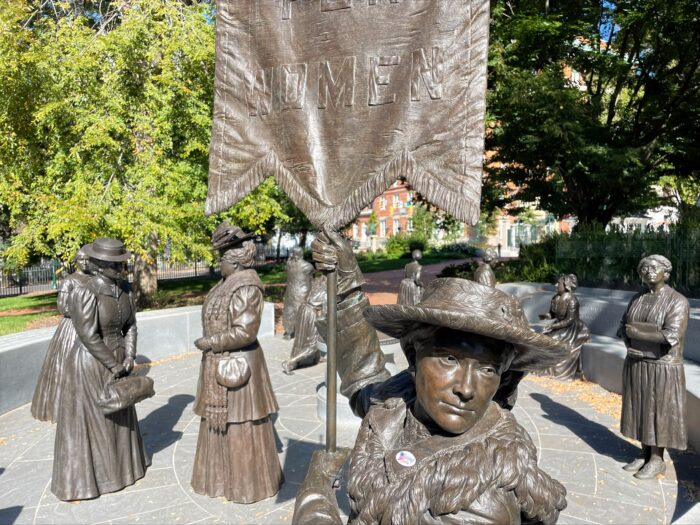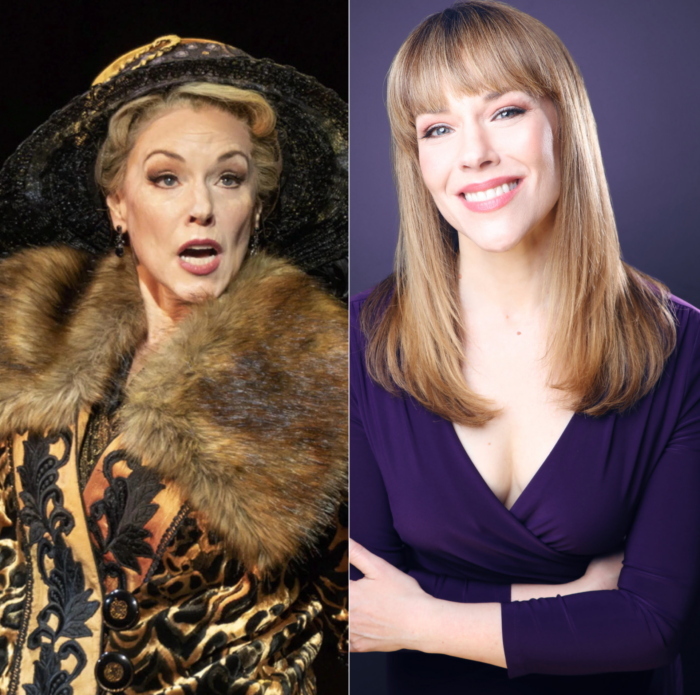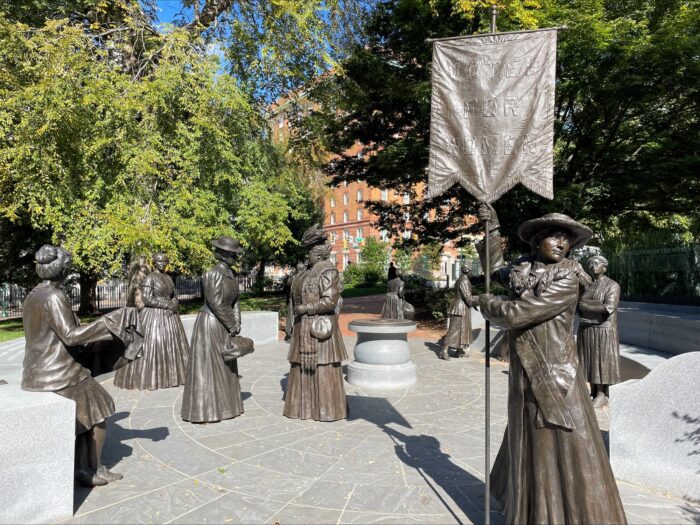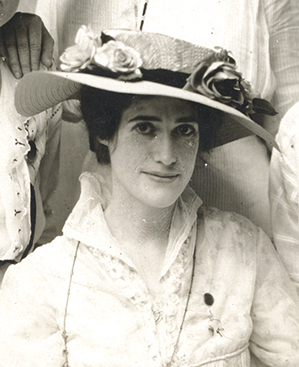
The statue of Adele Goodman Clark (foreground) at the Virginia Women’s Monument (BizSense file photo)
Ascending downtown’s steep Capitol Square hill in late August a bronze figure winks at me. The life-size statue depicts Adele Goodman Clark (1882-1983), a Richmond artist and suffragist.
Like the square’s other monuments such as those honoring Edgar Allan Poe, Jonathan “Stonewall” Jackson, and Barbara Johns, Clark’s life-sized image is set among defining brick walkways and towering trees. But her realistically sculpted form is just one of 11 figures that comprise a tableau, “Voices in the Garden: The Virginia Women’s Monument.” Cockacoeske, a Pamunkey tribal chief in the late 1600s; Martha Washington; businessperson and civic leader Maggie L. Walker (1864-1934); and educator Virginia Randolph (1874-1958) reflect the range of personalities depicted.
The engagingly dramatic work, sculpted by New York-based StudioEIS, was completed in October 2019. But there are two reasons most folks aren’t familiar with the women’s monument. First, it was installed at the beginning of the COVID-19 epidemic. Secondly, the leafy section of Capitol Square it occupies has been hard to navigate due to final construction of the General Assembly Building and repaving work on the square’s entry road nearby at East Grace and North Ninth streets.
I was primed to notice Clark that day because, in addition to having personally known the smart and gracious centenarian, the previous night I’d watched the Chicago Democratic convention broadcast. Women delegates wore white, a symbol of the suffragist movement in the early 20th century, to salute Kamala Harris as she accepted the nomination that could lead to her becoming our nation’s first female president.
Also, I’d recently been familiarized with the fraught story of how the 19th Amendment came to pass at a Broadway performance of “Suffs,” the current musical that won Tony awards for its book and music, both written by the show’s remarkable lead Shaina Taub (also its director). Truth to tell, the historically based “Suffs” attracted me because it features Emily Skinner, an accomplished actress and native Richmonder who’s receiving glowing reviews for her performance in which she plays two quite different pivotal characters. Alva Belmont was a wealthy and glamorous socialite who financed the suffragist movement. Phoebe Burn was a well-educated, Tennessee farm woman who in 1920 persuaded her son, at 24 the youngest member of Tennessee’s legislature, to defy his fellow Republicans to vote “Aye” to ratify the proposed amendment. Burn’s tie-breaking vote made Tennessee the deciding state in giving women the vote.
“Emily Skinner absolutely kills her scenes as Alva Belmont,” raved Sara Holdren, the New York magazine theater critic.
“My costume does the work,” said Skinner of the fur-adorned ensemble that outshines every other outfit in the production (and reportedly weighs 90 pounds). We spoke by phone a few days after I’d seen the show. But more seriously, Skinner said she is especially pleased to play the more understated role of Phoebe Burn: “I really feel like it was the power of the mother that made the 19th Amendment possible.” In her plaintive, country-western tinged ballad, “A Letter from Harry’s Mother,” Skinner as Burn pleads with her legislator son: “Let your Mamma know that she raised a good one.”
Skinner discovered theater early. “I was hyper as a young girl in kindergarten and was allowed to entertain the class for ten minutes each day to release the energy.” While attending John B. Cary Elementary School she worked with puppets.
“Later, I discovered my mother’s cast albums of Broadway shows. Occasionally, she’d take me to Broadway plays,” said Skinner, “I saw plays at the Virginia Museum (VMFA) theater and at the Mosque (now Altria Theater). A national tour of “A Chorus Line” made a big impact. And Richmond has always had rich professional and community theaters. In the 1970s I worked in all of them.”
After graduating from Richmond’s Community High School, she moved to Pittsburgh where she attended Carnegie Mellon University. Upon graduation her professional acting career took her to New York and Los Angeles. In 1998 she received a Tony nomination for best actress in a musical for “Side Show.”
“My favorite thing as an actress is to work on original, outside-of-the box stuff. The landscape of musical theater is changing, and I always hope that I can do something new.”
Back in Richmond’s Capitol Square, Adele Goodman Clark’s frozen sculpted visage is as powerful in its way as Skinner’s live performance. Striking an uncompromising stance, her feet are solidly planted, her suffragist banner firmly gripped, and her determined gaze lasers the nearby statehouse. She was a Jewish daughter of Alabama whose family moved to Richmond when she was young. After attending what is today St. Catherine’s School, she studied art in New York City and became a highly regarded Virginia artist and teacher. In 1909, she and 19 Virginia women founded the Equal Suffrage League of Virginia (Lila Meade Valentine was its first president).
Clark attended national women’s suffrage conventions and for years campaigned doggedly here for women’s right to vote. She and her multi-talented artist friend Nora Houston (a niece of the local Gilded Age tycoon and philanthropist James Dooley who built Maymont) would proselytize in non-confrontational but clever ways. One ploy was placing their painting easels on a busy downtown sidewalk at Fifth and Broad streets. When passersby stopped to inspect their artistry, the pair would steer the conversation to advocating for women’s right to vote. Despite their efforts, however, the Virginia General Assembly failed to add its voice to the winning tally, as had Tennessee for passage of the 19th Amendment in 1920.
I knew Clark, she and my family were friends and neighbors in Ginter Park. Although she was aged and seemed remote when I was a boy, after college I realized what a personage and icon she was. I’d take my more erudite friends to visit her at the rambling, once-grand, old house (with a painting studio in the backyard) she shared with Willoughby Ions, her cousin and probably partner. Cracked plaster walls and ceilings and oversized brown furniture populated the front hall and front rooms. But when she spread a brilliant red tablecloth on the round dining table and poured us inexpensive sherry, things turned magical. The banter was always lively and forward thinking. When any willing piano players hit the keys of the grand piano, co-host Ions, no shrinking violet, would sing along caw-like.
Always young-in-spirit, Clark, approaching her 100th birthday, referred to these salons as “The Brattery.” We brats took it as a high compliment.
When I asked Skinner if she was familiar with Adele Clark, the Broadway “suffragist” said not. Perhaps when home to visit her parents she will visit “Voice in the Garden.” If musical theater is changing, so is the landscape of historical monuments.

The statue of Adele Goodman Clark (foreground) at the Virginia Women’s Monument (BizSense file photo)
Ascending downtown’s steep Capitol Square hill in late August a bronze figure winks at me. The life-size statue depicts Adele Goodman Clark (1882-1983), a Richmond artist and suffragist.
Like the square’s other monuments such as those honoring Edgar Allan Poe, Jonathan “Stonewall” Jackson, and Barbara Johns, Clark’s life-sized image is set among defining brick walkways and towering trees. But her realistically sculpted form is just one of 11 figures that comprise a tableau, “Voices in the Garden: The Virginia Women’s Monument.” Cockacoeske, a Pamunkey tribal chief in the late 1600s; Martha Washington; businessperson and civic leader Maggie L. Walker (1864-1934); and educator Virginia Randolph (1874-1958) reflect the range of personalities depicted.
The engagingly dramatic work, sculpted by New York-based StudioEIS, was completed in October 2019. But there are two reasons most folks aren’t familiar with the women’s monument. First, it was installed at the beginning of the COVID-19 epidemic. Secondly, the leafy section of Capitol Square it occupies has been hard to navigate due to final construction of the General Assembly Building and repaving work on the square’s entry road nearby at East Grace and North Ninth streets.
I was primed to notice Clark that day because, in addition to having personally known the smart and gracious centenarian, the previous night I’d watched the Chicago Democratic convention broadcast. Women delegates wore white, a symbol of the suffragist movement in the early 20th century, to salute Kamala Harris as she accepted the nomination that could lead to her becoming our nation’s first female president.
Also, I’d recently been familiarized with the fraught story of how the 19th Amendment came to pass at a Broadway performance of “Suffs,” the current musical that won Tony awards for its book and music, both written by the show’s remarkable lead Shaina Taub (also its director). Truth to tell, the historically based “Suffs” attracted me because it features Emily Skinner, an accomplished actress and native Richmonder who’s receiving glowing reviews for her performance in which she plays two quite different pivotal characters. Alva Belmont was a wealthy and glamorous socialite who financed the suffragist movement. Phoebe Burn was a well-educated, Tennessee farm woman who in 1920 persuaded her son, at 24 the youngest member of Tennessee’s legislature, to defy his fellow Republicans to vote “Aye” to ratify the proposed amendment. Burn’s tie-breaking vote made Tennessee the deciding state in giving women the vote.
“Emily Skinner absolutely kills her scenes as Alva Belmont,” raved Sara Holdren, the New York magazine theater critic.
“My costume does the work,” said Skinner of the fur-adorned ensemble that outshines every other outfit in the production (and reportedly weighs 90 pounds). We spoke by phone a few days after I’d seen the show. But more seriously, Skinner said she is especially pleased to play the more understated role of Phoebe Burn: “I really feel like it was the power of the mother that made the 19th Amendment possible.” In her plaintive, country-western tinged ballad, “A Letter from Harry’s Mother,” Skinner as Burn pleads with her legislator son: “Let your Mamma know that she raised a good one.”
Skinner discovered theater early. “I was hyper as a young girl in kindergarten and was allowed to entertain the class for ten minutes each day to release the energy.” While attending John B. Cary Elementary School she worked with puppets.
“Later, I discovered my mother’s cast albums of Broadway shows. Occasionally, she’d take me to Broadway plays,” said Skinner, “I saw plays at the Virginia Museum (VMFA) theater and at the Mosque (now Altria Theater). A national tour of “A Chorus Line” made a big impact. And Richmond has always had rich professional and community theaters. In the 1970s I worked in all of them.”
After graduating from Richmond’s Community High School, she moved to Pittsburgh where she attended Carnegie Mellon University. Upon graduation her professional acting career took her to New York and Los Angeles. In 1998 she received a Tony nomination for best actress in a musical for “Side Show.”
“My favorite thing as an actress is to work on original, outside-of-the box stuff. The landscape of musical theater is changing, and I always hope that I can do something new.”
Back in Richmond’s Capitol Square, Adele Goodman Clark’s frozen sculpted visage is as powerful in its way as Skinner’s live performance. Striking an uncompromising stance, her feet are solidly planted, her suffragist banner firmly gripped, and her determined gaze lasers the nearby statehouse. She was a Jewish daughter of Alabama whose family moved to Richmond when she was young. After attending what is today St. Catherine’s School, she studied art in New York City and became a highly regarded Virginia artist and teacher. In 1909, she and 19 Virginia women founded the Equal Suffrage League of Virginia (Lila Meade Valentine was its first president).
Clark attended national women’s suffrage conventions and for years campaigned doggedly here for women’s right to vote. She and her multi-talented artist friend Nora Houston (a niece of the local Gilded Age tycoon and philanthropist James Dooley who built Maymont) would proselytize in non-confrontational but clever ways. One ploy was placing their painting easels on a busy downtown sidewalk at Fifth and Broad streets. When passersby stopped to inspect their artistry, the pair would steer the conversation to advocating for women’s right to vote. Despite their efforts, however, the Virginia General Assembly failed to add its voice to the winning tally, as had Tennessee for passage of the 19th Amendment in 1920.
I knew Clark, she and my family were friends and neighbors in Ginter Park. Although she was aged and seemed remote when I was a boy, after college I realized what a personage and icon she was. I’d take my more erudite friends to visit her at the rambling, once-grand, old house (with a painting studio in the backyard) she shared with Willoughby Ions, her cousin and probably partner. Cracked plaster walls and ceilings and oversized brown furniture populated the front hall and front rooms. But when she spread a brilliant red tablecloth on the round dining table and poured us inexpensive sherry, things turned magical. The banter was always lively and forward thinking. When any willing piano players hit the keys of the grand piano, co-host Ions, no shrinking violet, would sing along caw-like.
Always young-in-spirit, Clark, approaching her 100th birthday, referred to these salons as “The Brattery.” We brats took it as a high compliment.
When I asked Skinner if she was familiar with Adele Clark, the Broadway “suffragist” said not. Perhaps when home to visit her parents she will visit “Voice in the Garden.” If musical theater is changing, so is the landscape of historical monuments.






And, Emily is one of a number of notable alumnae of Richmond’s School of the Performing Arts – SPARC!
Such rich history and arts in Richmond!